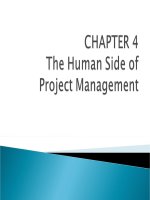chapter 2 it project manager
Bạn đang xem bản rút gọn của tài liệu. Xem và tải ngay bản đầy đủ của tài liệu tại đây (1.51 MB, 30 trang )
Define what a methodology is and describe the role
it serves in IT projects.
Identify the phases and infrastructure that makes
up the IT project methodology.
Develop and apply the concept of a project’s
measurable organizational value (MOV).
Describe and be able to prepare a business case.
Describe the project selection process
A strategic level plan for managing and
controlling IT projects.
A template for initiating, planning and
developing an information system.
Recommends:
◦ phases
◦
deliverables
◦
processes
◦ tools
◦
knowledge areas
Must be flexible and include best “practices”
learned from experiences over time.
Phase 1: Conceptualize and Initialize
Phase 2: Develop the Project Charter and
Detailed Project Plan defined in terms of
project’s:
◦
scope
◦
schedule
◦
budget
◦
quality objectives
Phase 3: Execute and Control the Project
using approach such as the SDLC
Phase 4: Close Project
Phase 5: Evaluate Project Success
◦
Post mortem by project manager and team of entire
project
◦
Evaluation of team members by project manager
◦
Outside evaluation of project, project leader and
team members
◦
Evaluate project’s organizational value
Project Management Processes
◦
Initiating processes
◦
Planning processes
◦
Executing processes
◦
Controlling processes
◦
Closing processes
Project Objectives
Definition of Business Case: an analysis of the
organizational value, feasibility, costs,
benefits and risks of the project plan.
Attributes of a good Business Case
◦
Details all possible impacts, costs, benefits
◦
Clearly compares alternatives
◦
Objectively includes all pertinent information
◦
Systematic in terms of summarizing findings
Step 1: Select the Core Team
Advantages:
Credibility
Alignment with organizational goals
Access to the real costs
Ownership
Agreement
Bridge building
Step 2: Define Measurable Organizational
Value (MOV) - the project’s overall goal.
◦
The project’s goal
◦
Measure of success
◦
Must be measurable
◦
Provides value to the organization
◦
Must be agreed upon
◦
Must be verifiable at the end of the project
◦
Guides the project throughout its life cycle
◦
Should align with the organization’s strategy and goals
1. Identify the desired area of impact
Potential Areas:
•
Strategic
•
Customer
•
Financial
•
Operational
•
Social
Organizational Value:
•
Better?
•
Faster?
•
Cheaper?
•
Do More? (growth)
3. Develop an Appropriate Metric
Should it increase or decrease?
Metrics:
•
Money ($ £ ¥ )
•
Percentage (%)
•
Numeric Values
4. Set a time frame for achieving the MOV
When will the MOV be achieved?
5. Verify and get agreement from the project
stakeholders
Project manager and team can only guide the process
6. Summarize the MOV in a clear, concise
statement or table.
MOV: The B2C project will provide a 20% return on
investment and 500 new customers within the
first year of its operation
This project will be successful if _________________.
Step 3: Identify Alternatives
◦
Base Case Alternative
◦ Possible Alternative Strategies
Change existing process without investing in IT
Adopt/Adapt systems from other organizational areas
Reengineer Existing System
Purchase off-the-shelf Applications package
Custom Build New Solution
Step 4: Define Feasibility and Asses Risk
◦
Economic feasibility
◦
Technical feasibility
◦
Organizational feasibility
◦
Other feasibilities
Risk focus on
◦
Identification
◦
Assessment
◦
Response
Step 5: Define Total Cost of Ownership
◦
Direct or Up-front costs
◦
Ongoing Costs
◦
Indirect Costs
Step 6: Define Total Benefits of Ownership
◦
Increasing high-value work
◦
Improving accuracy and efficiency
◦
Improving decision-making
◦
Improving customer service
Step 7: Analyze Alternatives using financial models
and scoring models
◦
Payback
Payback Period = Initial Investment
Net Cash Flow
= $100,000
$20,000
= 5 years
◦
Break Even
Materials (putter head, shaft, grip, etc.) $12.00
Labor (0.5 hours at $9.00/hr) $ 4.50
Overhead (rent, insurance, utilities, taxes,
etc.)
$ 8.50
Total $25.00
If you sell a golf putter for $30.00 and it costs $25.00 to make, you have
a profit margin of $5.00:
Breakeven Point = Initial Investment / Net Profit Margin
= $100,000 / $5.00
= 20,000 units
◦
Return on Investment
Project ROI
Project ROI
=(total expected benefits – total expected costs)
=(total expected benefits – total expected costs)
total expected costs
total expected costs
= ($115,000 - $100,000)
= ($115,000 - $100,000)
$100,000
$100,000
= 15%
= 15%
◦
Net Present Value
Year 0 Year 1 Year 2 Year 3 Year 4
Total Cash Inflows $0 $150,000 $200,000 $250,000 $300,000
Total Cash Outflows $200,000 $85,000 $125,000 $150,000 $200,000
Net Cash Flow ($200,000) $65,000 $75,000 $100,000 $100,000
NPV = -I
0
+ Σ (Net Cash Flow / (1 + r)
t
)
Where:
I = Total Cost or Investment of the Project
r = discount rate
t = time period









